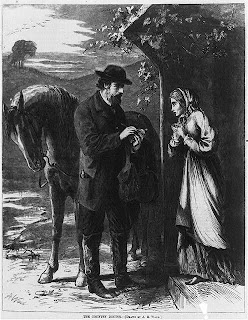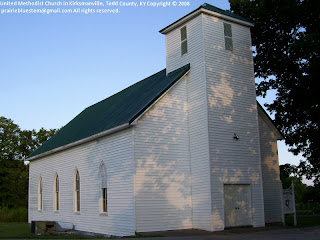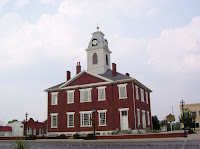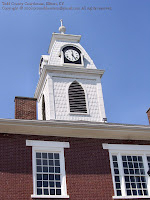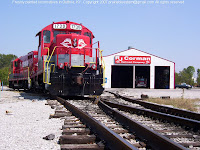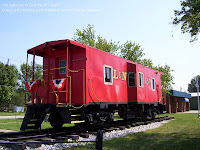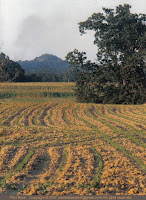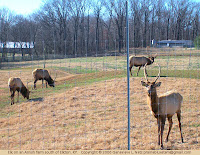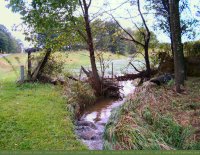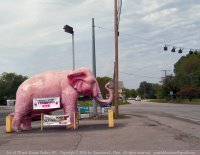Life in Christian County, Kentucky...
I posted a
photo of a Mennonite buggy a couple of days ago and
Erik asked in a comment, "Any idea how large the Mennonite community is around you? Any Amish as well?"
I sat down and tried to answer that question accurately, and I wrote so much that I decided it should probably be a separate post. And then I wrote some more. It turned out that I had quite a bit to say.
 Mennonite and Amish influx to Christian and Todd Counties
Mennonite and Amish influx to Christian and Todd CountiesChristian County and Todd County (KY) have seen a lot of Mennonite and Amish immigration over the last few decades. I think it really began during the late 1970's which was a rough time for U.S. farmers. Interest rates were unbelievably high and many areas suffered severe drought. Farm bankruptcies rose across the nation and continued throughout the 1980's.
As nice farms in Christian and Todd Counties came on the market, Mennonite and Amish families (especially from Pennsylvania) began moving into the area. They were able to sell their farmland back east at a good price for development and industry, and they got a lot more land for their money when they reinvested it here.
When we first moved here almost 16 years ago, some local residents seemed to be very hostile about the influx of Mennonite and Amish families. There was a lot of resentment about local farmers going broke and losing their land, only to see it sold to Mennonites and Amish. The Kentucky New Era, our local newspaper, wrote several articles about vandalism and hate pamphlets.
I believe that the Mennonites and Amish are better accepted now that people have grown accustomed to them and perhaps have even become acquainted with some of them. After all, they are just people, much like you and me in many ways. Where there is ill will now, it is most often about the damage done to highways by the steel shoes on horses and the steel wheels on buggies and equipment.
Mennonite farms in our immediate neighborhood
It is hard for me to estimate the size of the Mennonite community in this part of Christian County, except to say that we have a large and ever-growing population. I tried to count the number of families within a 2-1/2 mile radius, and I came up with at least 11 Mennonite households, two of which are childless, but most of the families have at least four children and some have seven or eight children. Within a five mile radius of our house, there are two Mennonite churches and four schools.
Mennonite and Amish families are good at making a living on a small acreage -- that's why we have so many families in such a small area. The
Fairview Produce Market (just five miles from us) has been a big help for produce growers.
Many of the families have dairies or big chicken houses and it's very common for them to have some kind of a repair shop or small store that they operate on their property. Within the 2-1/2 mile radius that I mentioned above, our Mennonite neighbors operate a greenhouse, a harness repair shop, a small-engine repair shop, a tractor repair shop, several chicken houses and three dairies -- in addition to doing regular farming of various sorts.
The church that our neighbors attend allows its members to have telephones and electricity, but does not permit automobile ownership or voting. All motorized implements must have steel wheels (to prevent them from becoming road vehicles.) I am not sure what designation this church applies to itself, but it is not Old Order.
We do have a large family of Old Order Mennonites nearby. (I think there are 16 brothers and sisters in the family but I don't know if they all live around here or not.) They use horses or mules in the fields and do not have electricity or telephones in their homes. They do not hire vehicles to go to town. If they must go to town, they drive their buggies or ride bicycles. Their school is included in my count above (within a five-mile radius). I am not sure if they meet at the school for Sunday worship or in homes.
Our Mennonite neighbor Clarence told us that the sons in this Old Order family have been marrying into another group that he called Canadian Mennonites. He says these Canadian Mennonites are even more conservative than the Old Order Mennonites are.
Amish settlements in Christian and Todd CountiesWe don't have any Amish families living near us, but there are areas of Christian and Todd Counties that do have settlements of Old Order Amish and New Order Amish. In Christian County, the New Order Amish seem to have settled mostly around Crofton (northern Christian County), and the Old Order Amish have settled in southern Christian County.
The Old Order Amish whom I have observed don't use electricity or tractors. They travel by horse and buggy or hire a driver if they're going far. Their clothing is usually dark in color. The ladies wear dark bonnets that come down onto their shoulders. I notice that the ladies use straight pins for their garment closures.
The New Order Amish dress more brightly. They drive to town in tractors pulling converted pickup-box trailers. The men drive and the women, children, and cargo are stowed in the trailers. Besides the settlements of New Order Amish around Crofton, KY, there are communities around Elkton, KY, and in southern Todd County.
Other Mennonites in the areaThere are also people whom I see that do not seem to fit into the four main categories I have described above, but their style of dress makes it evident that they are from other Mennonite or Amish groups. Some of them may be Brethren which is another Anabaptist group.
For example, a fellow whom our Mennonite neighbors call a "Russian Mennonite" built a kitchen cabinet for us. This cabinet maker drives a pickup truck and has electricity and a telephone. His family's style of dress makes it very evident that they are Mennonite. They do not attend a local church, but travel to southern Missouri once a month to worship with a church that shares their particular beliefs.
Today, another Mennonite man who is not a member of any local church is helping my husband with some plumbing. He drives a van. He and his wife have a Christian bookstore in their home that caters particularly to local Mennonites. They also publish a catalog and do a mail-order book business.
Another large Mennonite family nearby (13 children, all grown now) attends church here but they do not take communion here. For communion, they go to Ohio. They are more liberal than the local Mennonite church. They drive a horse and buggy, but they don't obey the rule about having only steel wheels on their tractors. (They don't have to obey the local Mennonite rules since they aren't "in communion" with the local church anyway.) Their children attended public school through 5th grade with our kids. Some of their children have married into Mennonite communities elsewhere that drive automobiles. Two of their children (that I know of) have married members of our local Mennonite church and have complied with its stricter lifestyle.
Importance of the church and communityI have read quite a bit about the Mennonite and Amish faiths and talked with our neighbors as well, and as I understand it, the particular practices of any community are determined entirely by a set of standards that the local church agrees on. The church may decide to allow gasoline motors on stationary farm equipment, for example, or to allow telephones but only in the barn.
A very important value that all these different Mennonite and Amish groups hold is
community. This is the underlying reason for avoiding motor vehicles, for example. First of all, motor vehicles take people places where they are exposed to outside influences, and secondly, they reduce the interdependence and cooperation of the community's members.
Even the telephone can be seen as dangerous because you may seek help and input from an outsider instead of going to speak face-to-face with your neighbor who is a friend and fellow church-member.
We have seen a few Mennonite familes sell out and move away from this area because they could not agree with the standards of the local Mennonite church. They wanted to live differently -- more conservatively or more liberally or whatever -- so they moved to another community that is more compatible with their beliefs.
Erik didn't ask to know all this about the Mennonites and Amish here, but
I seemed to think this lengthy explanation was necessary in order to accurately describe our neighborhood and community.


Technorati tags:

 Idlewild was nominated for the National Historic Register by Miss Dolly Banks in 1980. Some architectural features mentioned in the application can be seen in the photo at right -- Corinthian columns (added sometime around 1900), stone lintels above all openings in the house, stone sills at the windows, and flush chimneys at the ends of the house.
Idlewild was nominated for the National Historic Register by Miss Dolly Banks in 1980. Some architectural features mentioned in the application can be seen in the photo at right -- Corinthian columns (added sometime around 1900), stone lintels above all openings in the house, stone sills at the windows, and flush chimneys at the ends of the house.





